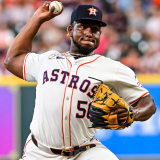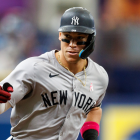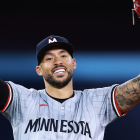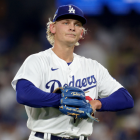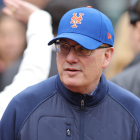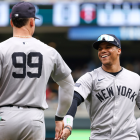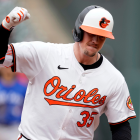
Major League Baseball will kick off the 2021 first-year amateur player draft on Sunday, July 11. This will be the first time the draft coincides with the All-Star Break festivities, and the event will be held in Denver, Colorado.
This will not be the first time the Pittsburgh Pirates make the top pick, however. The Pirates have held the No. 1 pick four times in the past, using it on right-handers Gerrit Cole, Bryan Bullington, and Kris Benson, as well as shortstop Jeff King. The most likely player to become this year's No. 1 pick is California prep shortstop Marcelo Mayer.
Here's what CBS Sports wrote of Mayer recently while ranking him as the best prospect in the class:
His boosters within the industry believe that he's the best player in the class: a potential 15-to-20-home-run-hitting shortstop who can deliver a good average and professional at-bats all the while. He isn't a fast runner, yet the smoothness of his defensive actions enable him to appear as though he's moving at a higher frames per second than the average prep shortstop. Depending on the extent of his projected power gains, he could finish his development with four plus tools (everything but the run), giving him a lofty ceiling that merits the top selection. Mayer is far more likely to become the first prep shortstop to go No. 1 since Royce Lewis in 2017 than he is to attend class in-person at USC this fall.
Since this is draft season, you might be wondering how some of the more recent No. 1 picks have worked out. With that in mind, let's touch on the 10 most recent top picks.
2011: Gerrit Cole, RHP, Pittsburgh Pirates
The last time the Pirates held the No. 1 pick, they used it on Cole. He spent five seasons in Pittsburgh, posting a 3.50 ERA and amassing 11 Wins Above Replacement, according to Baseball Reference's calculations. Unfortunately for the Pirates, Cole didn't evolve into his more dominant self until after being traded to the Houston Astros in exchange for Joe Musgrove, Colin Moran, Michael Feliz, and Jason Martin. Cole has since joined the New York Yankees after signing a nine-year contract worth $324 million, the richest for a pitcher in MLB history. Anthony Rendon, Francisco Lindor, George Springer, Trevor Story, and Javier Báez were some of the other first-round picks this year.
2012: Carlos Correa, SS, Houston Astros
The first of three consecutive No. 1 picks for the Astros, Correa's selection introduced the portfolio approach to drafting. The Astros saved more than a million dollars by drafting him over Byron Buxton, and they used those leftover funds to draft (and sign) Lance McCullers Jr. and Rio Ruiz. Correa, for his part, has been quite good when healthy. He's a career .278/.358/.485 hitter who has produced more career WAR than anyone else drafted in the round, including Corey Seager, Marcus Stroman, Kevin Gausman, and Matt Olson.
2013: Mark Appel, RHP, Houston Astros
The Astros tried the portfolio approach again the ensuing draft, signing Appel for nearly $400,000 less than the No. 2 pick (Kris Bryant) received. This class didn't work out nearly as well for them, with Appel being shipped off to Philadelphia in the Ken Giles trade after two full professional seasons. He's since retired, only to unretire this season. The Astros, who did net a few notables later in the draft (including Tony Kemp and the aforementioned Jason Martin) would've been better off taking Bryant or No. 3 pick Jon Gray, or, with the benefit of hindsight, reaching for Aaron Judge or Tim Anderson.
2014: Brady Aiken, LHP, Houston Astros
In a roundabout way, this pick worked out well for the Astros; less so for Aiken himself, who went unsigned after he was discovered to have an irregular ulnar collateral ligament. Aiken would be drafted 17th a year later by Cleveland. He never found his footing before requiring elbow surgery, and he hasn't appeared in a minor-league contest since 2019. The Astros would gain the second pick in the next draft as compensation, which they used to take Alex Bregman. In a redraft, the No. 1 pick would be one of Aaron Nola, Matt Chapman, and Trea Turner.
2015: Dansby Swanson, SS, Arizona Diamondbacks
Swanson's selection is most notable because the Diamondbacks traded him to Atlanta six months later as part of a package for Shelby Miller. It's fair to write that Swanson's career .247/.317/.400 slash line isn't what you'd want from the No. 1 pick, but he still ranks fourth in the first round in WAR. Who's ahead of him? Bregman, of course, as well as Andrew Benintendi and Walker Buehler.
2016: Mickey Moniak, OF, Philadelphia Phillies
Moniak made his big-league debut last season, but he's spent most of this year in Triple-A, hitting .209/.277/.399 with a 30 percent strikeout rate. That is, to quote manager Joe Girardi, not what you want. Moniak won't celebrate his 24th birthday until next May, so there's still some hope he can turn into a fourth outfielder. In retrospect, the Phillies would've been better off picking Will Smith or Ian Anderson. This has been, by and large, a disappointing class.
2017: Royce Lewis, SS, Minnesota Twins
Coming into the 2019 season, Lewis appeared to be one of the best prospects in baseball. He's since had his ascent slowed by a failed swing change, a global pandemic, and a torn ACL that sidelined him for the year. Lewis turned 22 in June, meaning time remains on his side. He may have to move to the outfield, however, and it's anyone's guess if and how his bat will recover. The most productive player from this round has been Trevor Rogers.
2018: Casey Mize, RHP, Detroit Tigers
The Tigers chose Mize with the expectation that he would be a quick-moving, above-average big-league starter. He's now more than 20 starts into his MLB career and he has a 102 ERA+ and a 2.49 strikeout-to-walk ratio. He's also tied for the most productive player in this round so far, with Nico Hoerner.
2019: Adley Rutschman, C, Baltimore Orioles
We recently covered why Rutschman is one of the best prospects in the minors. The short version is that he's a switch-hitting catcher who is crushing Double-A and who has a real shot at possessing four plus or better tools at his peak. Rutschman has all the makings of becoming an All-Star in short order.
2020: Spencer Torkelson, 1B, Detroit Tigers
Torkelson, in his first pro season, has already bullied his way to Double-A by hitting .312/.440/.569 in High-A. The Tigers are still having him split time between the infield corners, but by the time he reaches the majors (likely next season) he figures to serve as their everyday first baseman.








